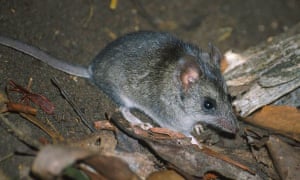The Kangaroo Island dunnart is among the animals most in need of assistance, a government analysis has found
The Kangaroo Island dunnart, the northern corroboree frog and the
Blue Mountains water skink are among 113 species that need urgent
attention after the bushfire crisis, according to a government analysis.
Nineteen mammals, 13 birds, 20 reptiles, 17 frogs, five invertebrates, 22 crayfish and 17 fish species have been identified as the animals most in need of assistance in coming weeks and months.
The list comes after the environment minister, Sussan Ley, convened an expert panel to analyse which species required short-term assistance and long-term recovery work in the coming weeks and months.
The list is based on consideration of how imperilled a species was
before the fire crisis, how much of its distribution area has burnt, and
what its likely response to fire would be.Nineteen mammals, 13 birds, 20 reptiles, 17 frogs, five invertebrates, 22 crayfish and 17 fish species have been identified as the animals most in need of assistance in coming weeks and months.
The list comes after the environment minister, Sussan Ley, convened an expert panel to analyse which species required short-term assistance and long-term recovery work in the coming weeks and months.
All of the animals on the list have had at least 30% of their range burnt and in some cases the figure is much higher.
“As we learn more about how species have responded on the ground, we will improve this list,” she said.
“More species might go on to it, but I’m hoping some will come off.”
The list includes species that were already listed under national environment laws as threatened before the fires and some, such as the Albert’s lyrebird and the parma wallaby, that were not.
The platypus is among a handful of species that have provisionally been included on the list while more information on how they have been affected by the fires is gathered.
There is particular concern for the Kangaroo Island dunnart, which has had 95% of its range burnt out, and the Kangaroo Island subspecies of the glossy black-cockatoo, which has lost much of its feeding habitat.
There are also fears that fires in East Gippsland will have pushed the long-footed potoroo closer to extinction.
Some fish species found in only one or two locations that have already been affected by drought are also considered at risk if ash and sediment flow into those waterways.
Ley said on Tuesday separate work was being done to prepare a list of plants but this list would require more time because of the large number of species to assess.
Plants already listed as threatened would be assessed first.
Work also has to be done to assess the impact of fires on most invertebrate groups.
Last month, the Morrison government announced an initial $50m in emergency funding for wildlife affected by the fires.
The intervention work will vary depending on what a species needs, but it could include supplementary feeding, building of nest boxes, predator control and, potentially, emergency relocation of fish species.
State governments have already commenced some work such as food drops for animals such as brush-tailed rock-wallabies that have survived fires but lost their feeding habitat.

No comments:
Post a Comment